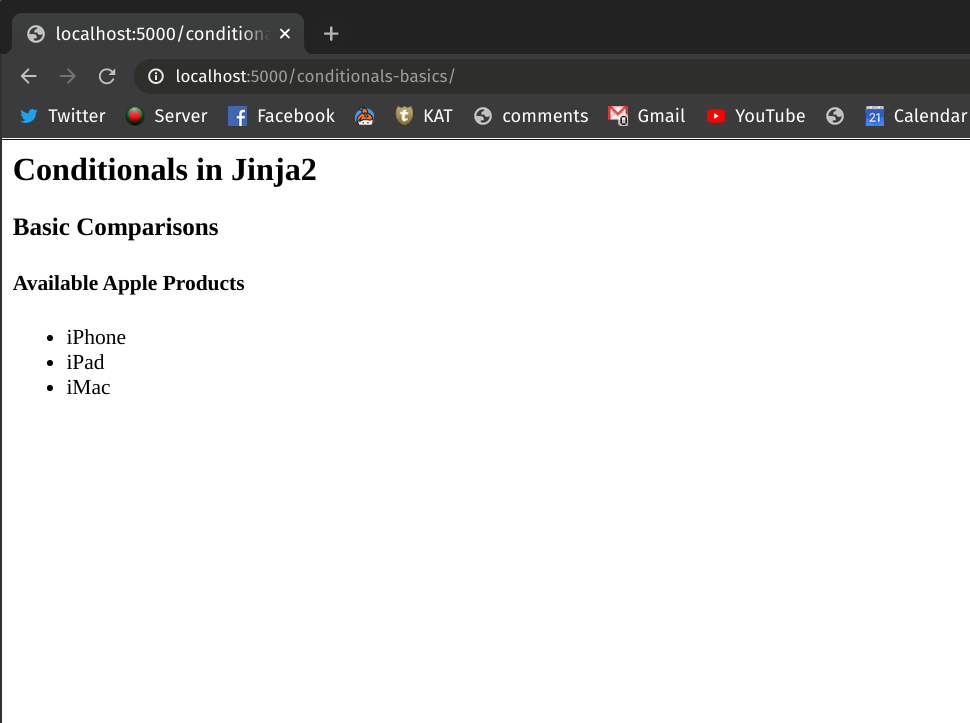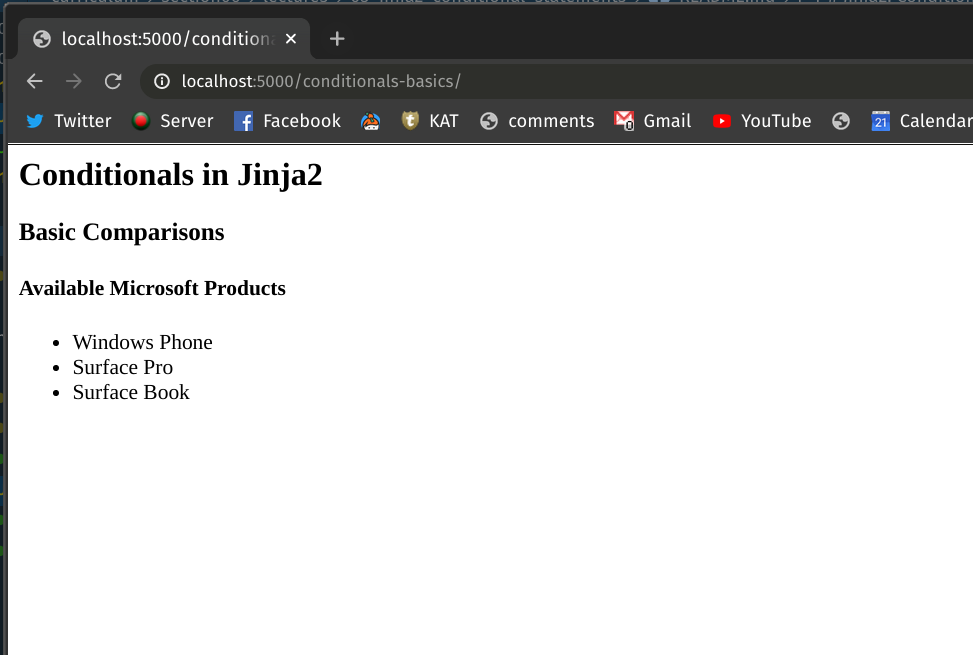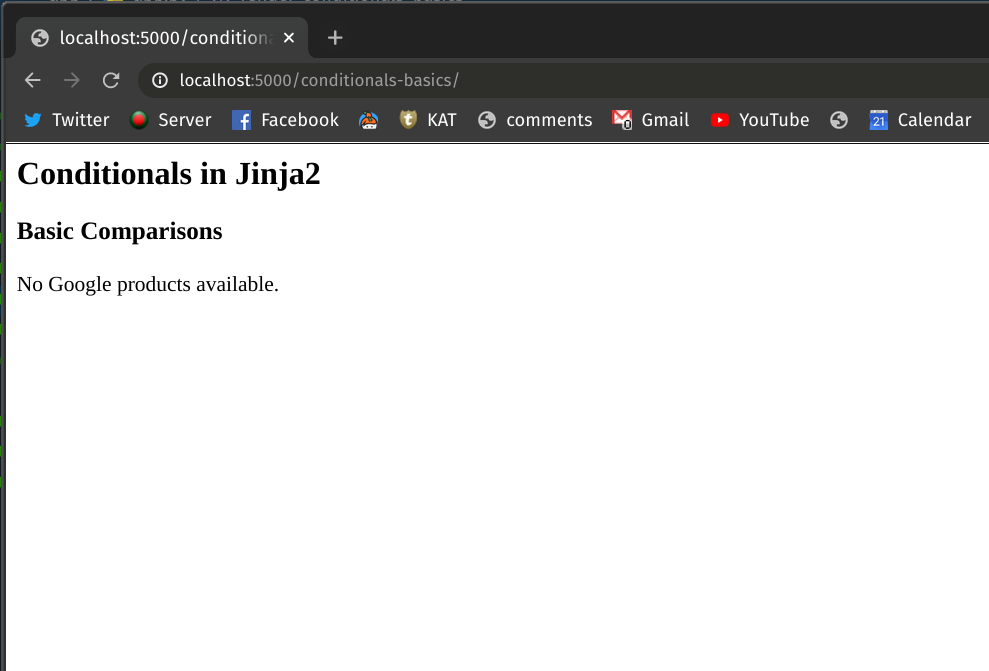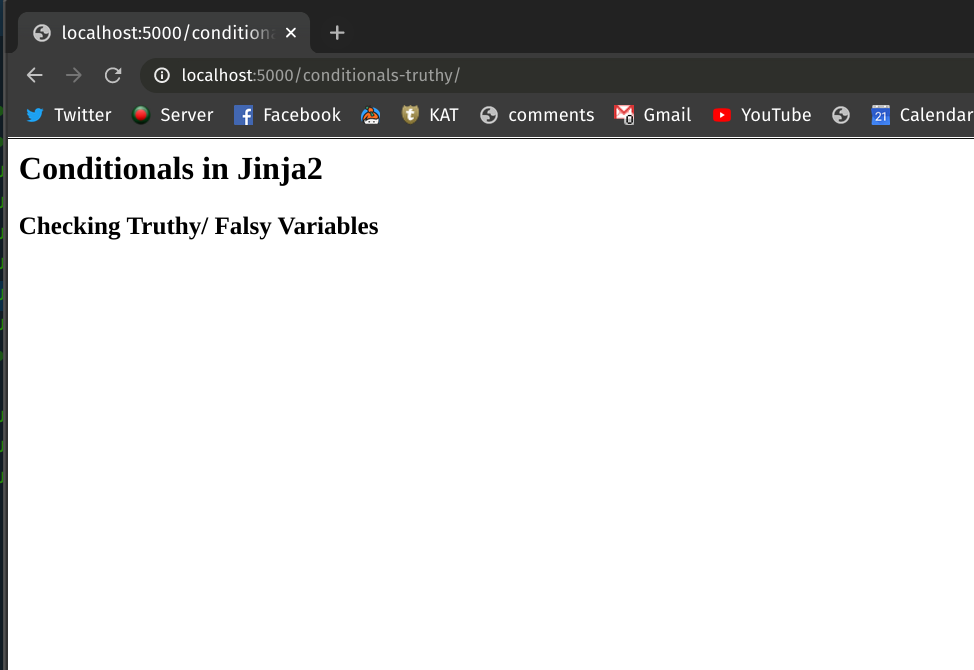# Jinja2: Conditional Statements
Conditional statements[1] perform different computations or actions depending on whether a programmer-specified boolean condition evaluates to true or false. Simply speaking, the if-else construct in your code is generally referred to as conditional statements.
Instead of dealing with
if...elseconditionals in the Flask code, you can directly embed them into the Jinja2 templates. With the default syntax, control structures appear inside{% ... %}blocks.
# Basic Comparisons
Define a template named conditionals_basics.html in your Flask project's /templates folder. In this example, we'll render different lists of products depending on the name of different companies provided by a user-defined variable called company. Here, we'll directly embed the conditional statements into the template.
<!-- templates/conditionals_basics.html -->
<h1>Conditionals in Jinja2</h1>
<h2>Basic Comparisons</h2>
{% if company == "Apple" %}
<h3>Available {{ company }} Products</h3>
<ul>
<li>iPhone</li>
<li>iPad</li>
<li>iMac</li>
</ul>
{% elif company == "Microsoft" %}
<h3>Available {{ company }} Products</h3>
<ul>
<li>Windows Phone</li>
<li>Surface Pro</li>
<li>Surface Book</li>
</ul>
{% else %}
No {{ company }} products available.
{% endif %}
Notice how we added conditional blocks to the template via {% %} blocks in line 6, 14 and 22. The {% endif %} block in line 25 marks the end of the conditional block. Now let's create an endpoint named /conditionals-basics/ in your Flask project's app.py file to render the template:
# app.py
from flask import Flask, render_template
app = Flask(__name__)
@app.route("/conditionals-basics/")
def render_conditionals_basics():
company = "Apple"
return render_template("conditionals_basics.html", company=company)
In line 10, we've provided the name of the company and passed that to the render_template method in the next line. Run the Flask application and go to http://localhost:5000/conditionals-basics (opens new window) on your browser. You should be able to see the following list:

Now change the variable company in the app.py from Apple to Microsoft and see what happens. Your app.py should look like this:
# app.py
from flask import Flask, render_template
app = Flask(__name__)
@app.route("/conditionals-basics/")
def render_conditionals_basics():
company = "Microsoft"
return render_template("conditionals_basics.html", company=company)
This time going to the http://localhost:5000/conditionals-basics (opens new window) on your brwoser should show a different list of products.

If you assign a different name other than Apple and Microsoft to the variable company, you'll see a "No product available" page.

# Checking Truthy / Falsy Values
You can also use conditional statements to test if a variable is truthy[2] (or falsy) and take action based on that. For a variable to be truthy, it has to be defined, not empty and not false. Make a new template named conditionals_truthy.html and add the following contents to it:
<!-- templates/conditionals_truthy.html -->
<h1>Conditionals in Jinja2</h1>
<h2>Checking Truthy / Falsy Variables</h2>
{% if user and user.username %}
<p>Hi, I'm {{ user.username }}.</p>
{% endif %}
The above template first checks whether the variable user is truthy and then it also checks whether attribute user.username is also a truthy value. If both of the conditions are true, the template returns the name defined in the user class.
Let's define an endpoint named /conditionals-truthy in the app.py file:
# app.py
from flask import Flask, render_template
app = Flask(__name__)
class User:
def __init__(self, username):
self.username = username
def __repr__(self):
return f"User({self.username})"
@app.route("/conditionals-truthy/")
def render_conditionals_truthy():
user = User("Adam")
return render_template("conditionals_truthy.html", user=user)
In line 8, we've defined a class called User. The class takes a single argument username. An instance of the class has been created in line 18. Here, the value of the argument username = "Adam" is truthy.
Run the Flask application and head over to http://localhost:5000/conditionals-truthy (opens new window) in your browser. You should see the template gets rendered like this:

Now if you instantiate the class User with a falsy value - for example, an empty string "" - the greeting statement of the template won't be rendered. Here, your app.py will look like this:
# app.py
from flask import Flask, render_template
app = Flask(__name__)
class User:
def __init__(self, username):
self.username = username
def __repr__(self):
return f"User({self.username})"
@app.route("/conditionals-truthy/")
def render_conditionals_truthy():
user = User("")
return render_template("conditionals_truthy.html", user=user)
This time if you go to the http://localhost:5000/conditionals-truthy (opens new window), you'll notice that the greeting statement hasn't been rendered.

# Conclusion
In this post, you've learned how to perform basic comparisons in Jinja2 templates using conditional statements. You've also seen how you can leverage truthy and falsy values of variables to control your logic directly from the Jinja2 template.
Enjoyed this article?
You'll love the complete video course!
- Complete video lessons for each topic
- Get the most out of your learning
- Build a portfolio of projects
- Get one-on-one help from a real person